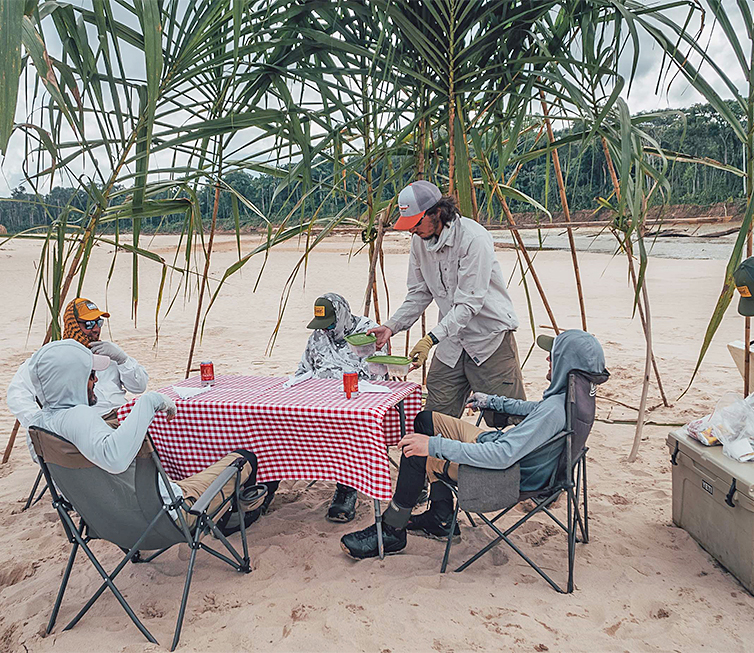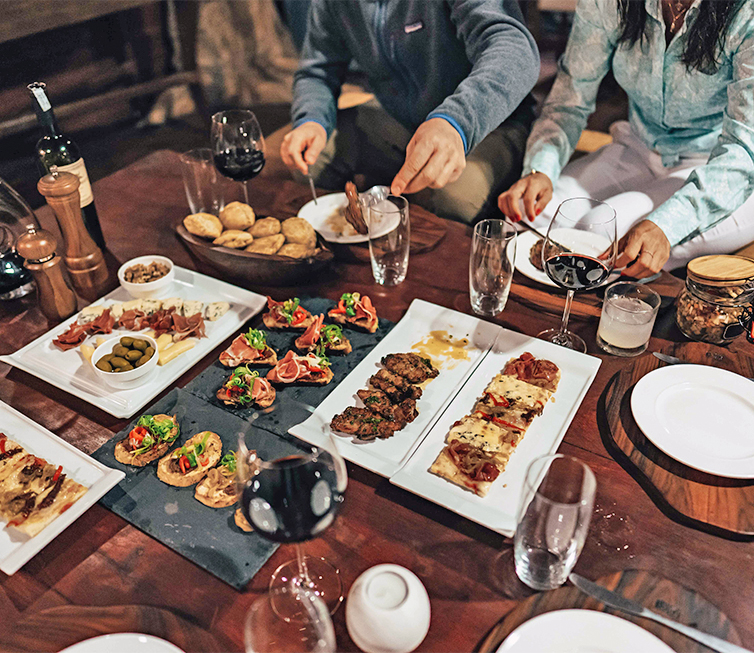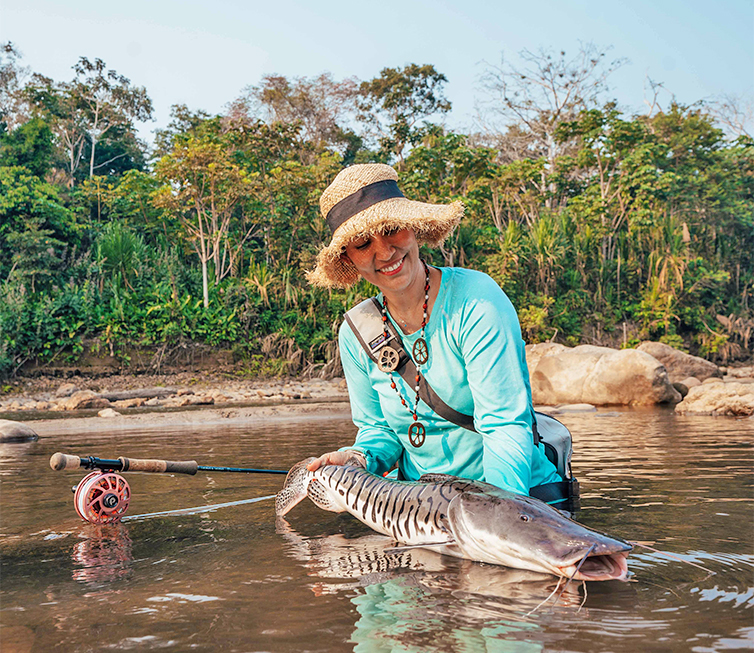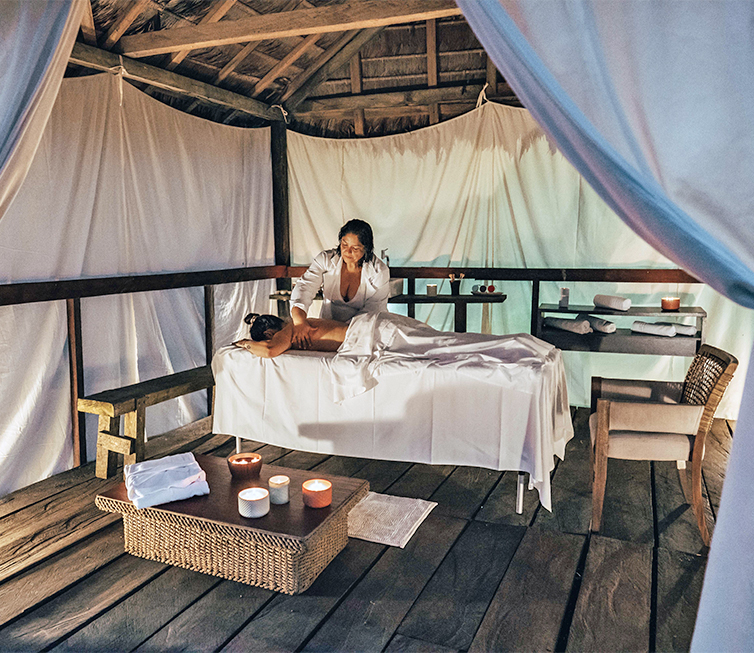Dorado may be the most bad ass fish that swims in freshwater!
Even in one of the most remote places in the world, guest will enjoy the comfort and style of a world-class destination at Pluma Lodge.
Based out of the comforts of the main Pluma Lodge and the two headwaters out-camps, anglers have access to three different rivers, each different and unique: the Pluma River, Itirizama River, and the lower Sécure River. This broad variety of waters and pools allow groups to fish fresh water every day, and rarely, if ever, repeat the same fishing beat. The water types vary from deep pools to rugged terraced pocket water.
The main Pluma Lodge features four log cabins and sleeps up to eight anglers. Each cabin has spring box beds, private bathrooms with hot water and electric light. Argentine wines and exceptionally-prepared International Cuisine will put an exclamation point on each and every action-packed angling day, with satellite internet wireless connection and phone service an added bonus.
The upper Pluma and Itirizama Headwaters Camps are a real paradise, located in the pristine headwaters of these two amazing mountain rivers. The camp operations are designed to offer additional options for exciting, upper and super remote sections of river for the most physically able, adventurous-minded anglers.
Pluma Lodge Waters: The accommodation offered at the lodge and camps allow anglers to access three rivers, which are each different in nature and character. The Pluma River, Itirizama River and the lower Sécure River. Its wide variety of waters and pools allow groups not to repeat beats during their 6 day stay. They can be caught in a wide variety of waters and using different techniques. Near those places there are magnificent fishing spots for pacu, yatoranas and catfishes such as tiger surubíes (South American striped catfish).
The Pluma River is a clear, medium-size freestone river whose structure is immensely rich and beautiful. The fact that it runs from south to north and parallel to the Mosetenes Mountain Range (without going deep into the mountains) makes it wider and more open; it is easy to wade there due to its wide banks composed by round shaped gravel and rock beds. Further upriver it gets narrower, its structure similar to a classic trout freestone river: it is full of shallow runs, boulders, and well defined deep pools and clear water. Fishing on the Pluma is done by walking and wading upstream, and at times using a Chiman canoe (no engine) which is very convenient especially for returning to the lodge at the end of the day. The lower Pluma extends from the confluence with the Itirizama River to its mouth in the Sécure River. The structure of this sector is similar to its higher reaches but with 50-60% more water volume. The pools are wider and deeper and the runs are more powerful. The increase in the water volume results in even more spectacular battles with the fish! The lower Pluma River beats are very accessible, and the fishing is carried out on canoes (without engines) running down stream. Anglers come back to the Lodge traveling by land on 4×4 vehicles through a jungle path. There are a wide variety of waters here, including steep drop offs, long runs, sandy flats, islands and deep pools.
The Itirisama River is similar in nature to the headwaters of the Pluma River; however, the Itirisama – considered by many anglers “the jewel in the crown” in Tsimane – has some extremely different features including swift runs, rapids, waterfalls and boulder-strewn pocket water. Very deep pools are found among those geographical features and they are generally on exposed stone slopes. Undoubtedly, this river offers the hardest hikes to access, so it is recommended only for anglers in very good physical condition. Its water is the coldest and the clearest of all Tsimane, so fishing can be very technical at times. The Itirisama is a fishery where one typically won’t catch as many fish; but it is home to the largest resident fish in the entire system.
The Lower Sécure River is the sector that goes from the confluence with the Pluma River to the Oromomo community. Here the Sécure River bottom has fine sediment and there are many sunken logs lining its banks. This is home to “Coruya”, one of the most active fishing beats in Tsimane due to the large number and the size of the dorados. There’s a large Delta region with numerous braided channels, sand bars and other features to concentrate baitfish, and therefore Dorado, in good numbers.
At Pluma Lodge there will be two “super dugouts” with comfortable casting and poling platforms. These custom-designed skiffs will allow anglers to fish more and better in comparison with the smaller dugout canoes. We will keep the dugout canoes for the upper Pluma and Itirizama Rivers since they really perform best in the smaller water there. The skiffs will have a base at Coruya port on the lower Sécure River, to fish all the lower Sécure, the delta area and 30 miles of new, never-before-fished water, below and downstream of the Oromomo community, only accessible with these new and faster boats.
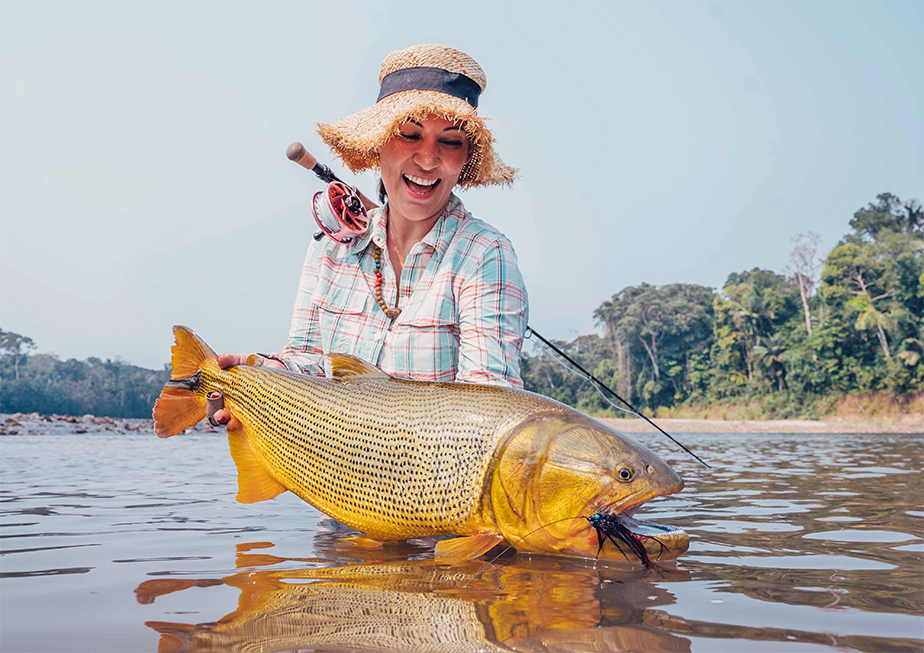
Reservations & Rates
The cost of the 9 night, 6 day fishing Pluma Lodge package is:
2025: $7,600per person plus $670 indigenous & national park fees
2026: $8,000 per person plus $670 indigenous & national park fees.
Inclusions
Included in your angling package at Pluma Lodge are two (2) nights at a 5 star hotel in Santa Cruz (single/private room), ground transfers in Santa Cruz upon arrival, charter flights – Santa Cruz – Lodge – Santa Cruz, 6 full days fishing with one pro guide and two local guides per two anglers in fishing areas, 7 nights lodging at Pluma Lodge, and all inclusive meals, beverages and spirits at the lodge. Winston Fly Fishing Rods to use.
Non-Inclusions
Not included in your angling package at Pluma Lodge are International Flights, Meals and Beverages in Santa Cruz Hotel, fly fishing leaders, wire and flies, tips and gratuities, and trip insurance, Airport taxes and US$550 Indian Communities Fee payable in Bolivia).
Native Community Tax: The Tipnis Natives (where Tsimane is located) have formed a board to protect their interests moving forward. This board includes representatives from all 22 Sécure River Communities, as well as all the communities in State of Beni. The leaders of the association have made the decision to implement a significant user tax on all visiting anglers. The funds from the tax will primarily be used for social projects, infrastructure development, transportation, and medical and education projects.
Travel Insurance
The Fly Shop® is not in the insurance business, but we recommend Travel Guard coverage as a service with a desire to see your best interests protected. It is impossible to know when an unfortunate situation (loss of luggage, fly rods, illness in the family, or an accident) may occur. However, such things can and do happen, and this insurance can provide a means of recourse against non-refundable financial losses.
• Travel Insurance Information
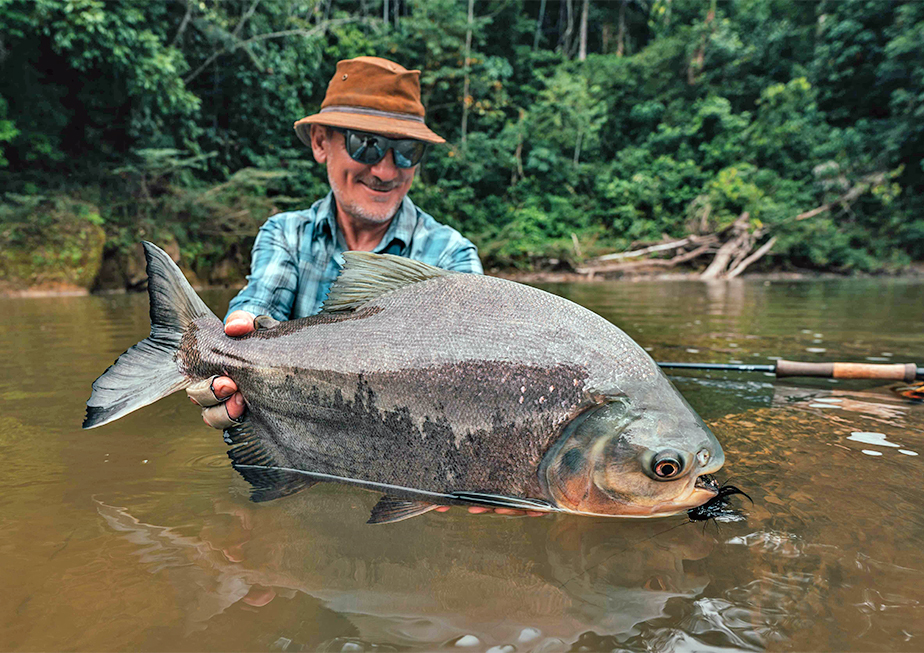
Seasons at Pluma Lodge
The season for Pluma Lodge runs from June through Mid October.
The fishinge at Pluma Lodge is timed to coincide with the dry season so the rivers will be at their lowest. Temperatures can see the 90's during the day and drop to the 50's or 60's at night over the course of its season. Of course, rains can come at ay time, but this is the best time of the year to fish there. The rivers are more like clear mountain trout streams where sight fishing is the rule.
Read More
Dorado, during their annual migration (on low/mid sections of rivers), are always following the schools of local baitfish, called Sabalo, as these are there primary source of food. The Sabalo (and corresponding Dorado) migration begins in March or April according the intensity of the rainy season and water level. By May and June schools of Sabalo and Dorado are running upstream and present throughout the river systems in good numbers. These migrations continue throughout the season, so fresh fish are constantly arriving in the upriver sections.
What we tend to see is that in the earlier parts of the season, there may be fewer fish in the river overall...but those fish are super hungry and incredibly aggressive to feed, making for some truly exciting action. As you get later and later in the season, there are indeed more fish around overall, though some of those fish have been in the system for an extended period of time and may not be quite as aggressive overall. In general, we find the balance between numbers of fish and aggressive behavior balance out, and hookups for anglers tend to be fairly consistent throughout the season. This means you can plan your trip around whenever you can be there, as ever week of the season has the potential to be the best!
This is the rainforest, with wild freestone rivers that are subject to runoff from periodic, intense storms. While blowouts are very rare, they can happen. Typically if the water comes up one day, it'll be fishable the next and seldom do anglers miss more than a couple of days without ideal conditions and hungry, happy fish.

Getting to Pluma Lodge
Getting to Bolivia these days is relatively simple and painless with a wide choice of convenient, daily flights from Los Angeles, Atlanta, Dallas, Miami, and New York.
Anglers will arrive in Santa Cruz, Bolivia where a lodge representative will be waiting for you in Viru Viru International Airport (VVI) and transfer you from the airport to the hotel, a five star property (included in the angling package – a 20-minute drive).
The trip packages begin at Santa Cruz, Bolivia. There are many daily flights from major cities of the US and world-wide. You will need a passport valid to 6 months past your departure from Bolivia. US citizens will need to get a visitor's visa for entry to Bolivia. At this time the cost of the visa is $160 USD and is
Read More
The next morning, you'll enjoy breakfast at the hotel. Tsimane’s local host will meet the group in the morning (usually around 9:30 am) to head to the local airport, where they will board the charter flight to the Oromomo Indian Community (1.5 hr flight). The guides will welcome the group there and transfer everyone to Pluma Lodge. This transfer is a 20 minute boat ride upstream to Sécure Coruya Dock, followed by a ride on 4x4 vehicles through a gorgeous road cut through the middle of the jungle. Upon arrival at Pluma Lodge, settling in, and preparing gear with the guides, there will be a brief explanation of the fishing week and the fishing beats rotation. There is time in the afternoon for a half day of DIY fishing at the home pools and nearby areas.
On your final day on the river, guests will pack up after breakfast and transfer back to the Oromomo Indian Community for the charter flight back to Santa Cruz (1.5 hrs). In Santa Cruz you will be met by a member of the Tsimane staff who will take you to the hotel to overnight (included in package), before flying home the next day.
Baggage Weight Limits:
Please restrain bringing unnecessary weight to the jungle lodges. Luggage weight Limit is 25 kilos (55 lbs). We use small planes for transfers and we are really strict in all safety measures and baggage weight limits are strictly adhered to. You will be able to leave items not needed at camp with the Hotel KAMP's concierge if you are returning to the hotel at the end of the week. We recommend this for traveling clothes, etc. (THERE IS DAILY LAUNDRY SERVICE @ ALL THE LODGES)
A Bolivian Tourist Visa is required for entry to Bolivia. This can be purchased in the airport (approximately $160) upon arrival, or obtained in advance. A passport with 6 months validity is required.
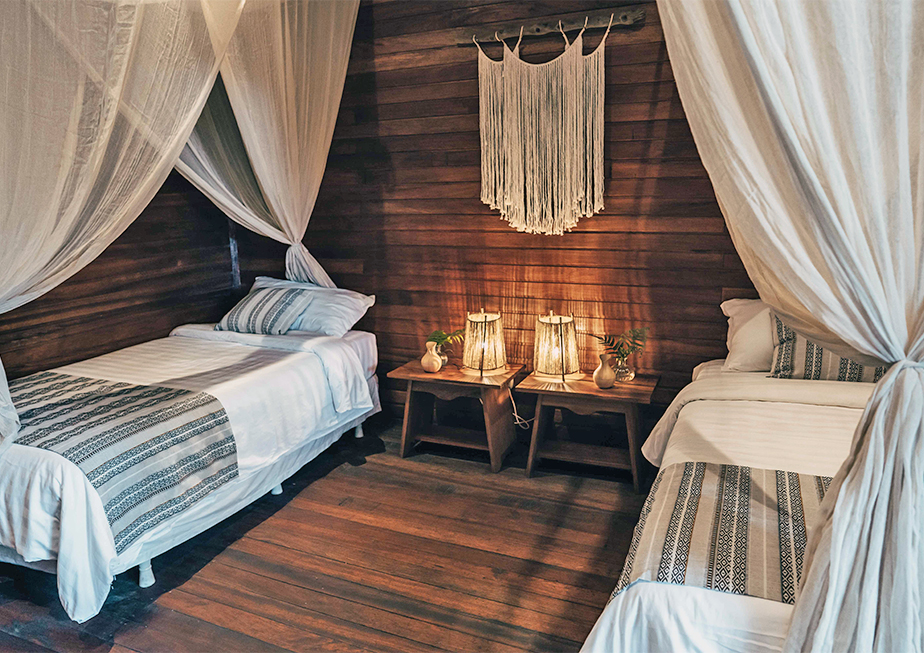
Lodging at Pluma Lodge
Even in one of the most remote places in the world, guest will enjoy the comfort and style of a world-class destination at Pluma Lodge. The uber-remote location of the Tsimane lodges creates extremely challenging and complicated logistics. Nonetheless, the exceptional team at Untamed Angling has managed to create world class lodge environments complete with first-rate staff, service, food, and style.
Read More
Generators provide electricity, 220-volts, so be sure to bring the proper adapters depending on your electronic device and country of origin. You can charge batteries and use electric shavers or hair dryers. Solar panels are also incorporated into the electronic grid for increased efficiency and sustainability. Electric power is available from 6:00 am to 10:00 am, and again from 5:00 pm to 12:00 am.
Laundry service is provided at no additional cost. Just leave your close on the floor, and they will be returned washed and folded. Complimentary wireless satellite internet connection is available.
The Tsimane Pluma Lodge is built entirely from sustainable wood cut from the nearby jungle. The main lodge features single/private wood cabins for each guest with a maximum occupancy of six anglers each week. Each cabin has spring box beds, private bathrooms with hot water and electric lights. Every evening guests will be delighted by the delicious International cuisine paired with great Argentine wines in a well-fashioned, spacious living and dining room.
There is also the option to do headwater out-camps for one night to the upper Pluma River and one on the upper Itirisama River, one of the main tributaries to the Pluma.

Fishing at Pluma Lodge
Each day angling pairs fish one of the many beats in the Pluma area, returning to the lodge at the end of the day. There are options to fish the upper Pluma and Itirizama river headwater camps, including overnight options at the out camps for one or two nights during the fishing week. Each headwater camp is suited for two anglers; this means two anglers in upper Pluma camps and two anglers in upper Itirizama camps. We recommend the upper Pluma/Itirizama camps only for well physically fit anglers, as all of the fishing is done walking and wading upstream and there is considerable hiking involved in reaching the upper camps. These headwater options aren’t for everyone, but allow the more adventurous anglers to extend their stay on the headwaters of these unique virgin
Read More
mountain rivers, for a once-in-a-lifetime sight casting jungle experience.
There will also be two larger skiffs at the lower secure area, each one with two spacious casting platforms and powerful outboard motors. They will be located at Coruya port and allow anglers to reach a new area downstream of Oromomo Community which is completely new for Tsimane guests.
Besides the Dorado (the king of the river) there are other species to pursue, such as Pacu (our jungle freshwater permit) and Yatoranas. Together these species make a trio very difficult to match in warm freshwater fly fishing. The rivers we fish are very similar to freestone trout rivers with similar looking pools, runs, pocket water, and riffles. If you are a good and pragmatic trout angler, you will feel comfortable reading and fishing our rivers.
Fishing in these rivers, regardless of the huge populations of fish, represents several challenges for the angler. These fish can be spooky in such small and clear water and every pool and run must be thought-out and a plan developed with your guide before casting a fly into it. Dorado are very fast swimmers, super aggressive and flies must be placed not only with accuracy but also at the right time. Anglers who are able to shoot 60 feet of line with one or two false casts will have a big advantage. Being able to double haul in order to generate line speed will be a huge advantage. The flies we use are generally quite large and most anglers find it difficult to cast them accurately, with distance – in a hurry. We encourage guests to practice in order to get familiar with their equipment, flies and lines.
It's also worth noting that it is important to go light, carrying what you need in your shirt and pants pockets; a few flies, a spool of mono and wire is all you need with pliers on your waist and nothing else. Leave the rest of the gear in the boat, which will always be located close by in case you need something out of your kit.
Setting The Hook:
Dorado, Yatorana and Pirapitinga have extremely bony and hard mouths. A low rod strip-set is the only method that consistently buries the fly hook into these fish’s mouth, just like a tarpon set. If you are not familiar with the strip-set, it might take some getting used to.
Catch & Release:
Tsimane practices a strict catch and release policy on all species. Avoid unnecessary handling of the fish. Barbless hooks are mandatory. Handling these fish requires special precautions, not only to avoid harming them but also to prevent injuries to anglers. All of these fish have very strong jaws and razor sharp teeth. And they know how to use them.
Wading:
Most of the fishing at Tsimane is done by wading in the river or fishing from the bank. The river structure varies tremendously, from sandy and small gravel beaches to sharp volcanic rock shoals transitioning through all kind of freestones and boulders. Wading is not difficult or dangerous; however there is a lot of it. We recommend guests to at least do some walking/running the weeks prior to their visit.
We strongly recommend our guests to wade behind their guides and to keep their eyes open. Stingrays are rare, but present in these waters and an unfortunate misstep can result in an extremely painful ordeal. For protection, stingray guards will be provided when necessary (you can bring yours if you want to). Together with a sturdy wading boot, keeping your eyes open and moving slowly you should experience no problems. It is very important to listen to your guide, follow behind him and his experienced and sharp eyes.
Wading Equipment:
Fast drying pants or shorts over a lightweight base layer (Patagonia Capilene # 1), sturdily built felt sole wading boots (with studs), gravel guards and stingray guards as well as a wading staff is recommended. We recommend bringing lightweight Gore-Tex waders during June-August months (optional), just in case it gets cool. Please do not bring rubber soled wading boots; they don’t work on the thin algae film that covers our rocks and gravel.
Fly Fishing Gear:
Fly Rods: 7, 8 or 9 weight single handed rods, 9 feet in length are highly recommended. The 8 weight is the Tsimane standard, but it might be necessary to have a 9 weight rod in certain situations, especially in the Lower Sécure River where HUGE Dorado frequent. We also recommend bringing a light 6 weight rod for fishing big dry flies for Yatoranas in small creeks and tributaries.
Ideally, you should have two rods rigged with different lines or flies at the boat. One 8/9 weight rigged with a good dorado streamer and other one with a Pirapitinaga fly. An extra backup rod will be necessary. Powerful rods with a strong butt section are a must. Saltwater fly rods are perfect.
Note: Consider carrying a spare rod with you each day, just in case you blow one up on these fish.
Fly Reels: As with rods, reels that have been designed for saltwater fly-fishing are the best choice. Fly reels that feature a strong, smooth disk drag with a large arbor spool are perfect. A big Dorado or Pirapitingas will easily have anglers into their backing. Bring a reel that you are comfortable with and that is in good working order. Weight of the reel is important; since you will be casting a lot, keep it light. 30 pound backing is required.
Fly Lines: Most of the fishing is done close to the surface. Weight forward floating lines for tropical waters is what you need. We’ve worked closely with Scientific Anglers to design a line specifically for use in these jungle environments: The SA Jungle Titan Taper. Other tropical lines like a General Saltwater Taper, Redfish Taper, Rio Outbound Tropical Short or comparable warm water fly lines will also work. At times a clear intermediate tip line (also available in the Jungle Taper) can be good, especially if a cold front moves through or rains bring the water up.
Do not bring conventional cold water floating lines, as the hot weather makes the lines turn soft and gummy.
It can also be a good idea to bring a fast sinking tip or shooting taper. For this we recommend a 200 or 250 grain 15 foot sink tip, just in case…
Leaders: Spools of Fluorocarbon should include 40, 30, 20 pound breaking strengths. Due the rocky river-bed and other aggressive fish in the rivers, we prefer fluorocarbon material. When fishing in off color waters or with sinking tip lines for Dorado, sophisticated leaders are not needed. However when fishing under normal clear water conditions with floating lines, everything changes. We tie some specific leaders according the species, the conditions and the size of fly we are using.
Normally, we use 6 - 9 foot leaders with a heavy butt section and 20 - 30 pound tippet breaking strength. This allows good presentation for big flies without spooking them. Our guides can assist you in building a leader for each fishing situation. You don’t need tapered leaders, just bring spools of 40#, 30#, and 20# Fluorocarbon.
Wire: All the fish we catch in Tsimane, are heavily armed with sharp teeth and wire tippet is necessary. Spools of 25 to 40 pound American Fishing Wire, Rio or Tiger Titanium are fine choices. Please bring wire tippets in grey or camouflage color. Pre-tied Leaders (for barracuda or pike) are not recommended.
Over the years we have learned that most of our guests under-estimate the amount of wire tippet they will go through during a week of fishing in Tsimane’s waters. One spool of tippet is rarely enough, and we recommend you bring two spools of 40# tippet, and one spool of 30# tippet.
Flies: For flies we predominantly use baitfish imitations, in full black, and/or a combination of black and red, purple, orange and yellow. Flies should swim well with good action and tied full with plenty of volume. Flies in lengths from 4 to 8 inches with barbless hooks 2/0 to 4/0 are the norm. High quality, saltwater hooks are required.
As for patterns the most typical fly used is the Andino Deceiver. It’s similar to regular Deceivers but with bead chain eyes and a muddler or craft fur head. However other baitfish imitations have proved to be very successful, among them; Puglisi Streamers in medium to very big sizes, Lefty's Deceiver or Umpqua's Tarpon's Snake are good options. Flies with lots of flash are not recommended.
Pole Dancers, Foam poppers, Titanic’s sliders (size BIG), big mouse imitations, and Dahlberg Divers are very good choices for Dorado on surface. Flies like the Chernobyl Ants or other big terrestrials and bugs imitations are excellent for Pirapitingas and Yatoranas.
Why We Endorse This Destination:
Tsimane’s Pluma Lodge
• THE MOST UNIQUE DORADO FISHERY IN THE WORLD
Tsimane is the only fishery we know of, anywhere in the World, where you can wade fish in clear mountain streams for Dorado. Tsimane is an extremely unique fishery, an exotic jungle fly fishing adventure, far off the beaten path and the #1 jungle fishing trip in World. If you had to make one jungle trip in your life, this is the trip; it will change you for life.
• THE MOST RESPECTED JUNGLE OUTFITTER IN THE WORLD
Tsimane is outfitted by the “Jungle Guys” Untamed Angling, the most experienced and recognized jungle outfitters in the world; the same fanatic anglers that discovered the Rio Marie’, the giant peacock bass fishing destination in Brazil. These folks are pros with years of operating experience in the Jungle; you are in very capable hands. The management and staff will take care of all the logistics, support and mechanics of the trip, all you have to do is fish as hard as you can and enjoy the experience.
• GIVING BACK TO THE ENVIRONMENT AND INDIGENOUS PEOPLES
Tsimane is an award winning collaborative program between local Indigenous Indians, the Bolivian Government and Untamed Angling in an effort to promote conservation, sustainability and culture. A portion of your dollars are making a difference in native’s life and the understanding and conservation of the Bolivian Jungle and its native species.
• DELUXE JUNGLE FISHING LODGE IN THE MIDDLE OF NOWHERE
Just because you’re in the most remote corner of the Bolivian Jungle mountain lands doesn’t mean you have to be uncomfortable. Anglers fishing at Tsimane are accommodated in a deluxe lodge boasting every imaginable amenity you would expect in a topnotch fishing lodge. Spacious guest rooms with full bathrooms, 24 hour power, ceiling fans along with fine cuisine prepared by a trained chef are what to expect. You sleep comfortably at night after a dining on world-class food and be well rested and fueled for a full day of fishing trophy dorado.
• WILDLIFE VIEWING ODYSSEY
Tsiamne Lodges are located in a National Park; an Indigenous Territory named TIPNIS, within the regions of Beni and Cochabamba. It is part of the Vilcabamba - Amboró Conservation Corridor, in the Sub-Andean strip of the tropical Andes between Peru and Bolivia. Every day angler will see hundreds of Macaws, Toucans, giant and colorful butterflies, different mammals like jaguars, tapirs, and native deer, all living inside a pristine jungle forest environment. Anglers come to Tsimane to fish, but are exposed to wildlife viewing odyssey like a National Geographic movie. Bring your camera and your binoculars for this trip, you don’t want to miss a thing…


